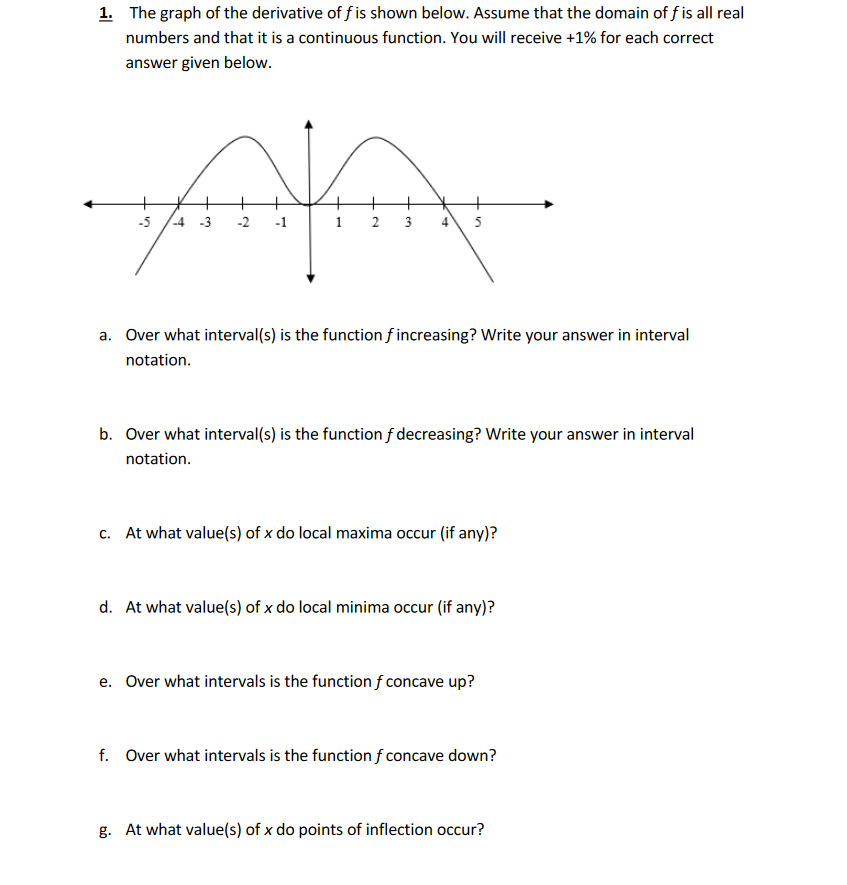: The graph of the derivative of f is shown below. Assume that the domain of f is all real numbers and that it is a continuous function. You will receive +1% for each correct answer given below. + -4 -3 -5 -2 -1 1 2 4 5 . Over what interval(s) is the function f increasing? Write your answer in interval notation. . Over what interval(s) is the function f decreasing? Write your answer in interval notation. At what value(s) of x do local maxima occur (if any)? . At what value(s) of x do local minima occur (if any)? . Over what intervals is the function f concave up? Over what intervals is the function f concave down? At what value(s) of x do points of inflection occur?
: The graph of the derivative of f is shown below. Assume that the domain of f is all real numbers and that it is a continuous function. You will receive +1% for each correct answer given below. + -4 -3 -5 -2 -1 1 2 4 5 . Over what interval(s) is the function f increasing? Write your answer in interval notation. . Over what interval(s) is the function f decreasing? Write your answer in interval notation. At what value(s) of x do local maxima occur (if any)? . At what value(s) of x do local minima occur (if any)? . Over what intervals is the function f concave up? Over what intervals is the function f concave down? At what value(s) of x do points of inflection occur?
College Algebra (MindTap Course List)
12th Edition
ISBN:9781305652231
Author:R. David Gustafson, Jeff Hughes
Publisher:R. David Gustafson, Jeff Hughes
Chapter3: Functions
Section3.3: More On Functions; Piecewise-defined Functions
Problem 99E: Determine if the statemment is true or false. If the statement is false, then correct it and make it...
Related questions
Question

Transcribed Image Text:1. The graph of the derivative of f is shown below. Assume that the domain of f is all real
numbers and that it is a continuous function. You will receive +1% for each correct
answer given below.
-5
-4
-3
-2
-1
1
2
4
5
a. Over what interval(s) is the function f increasing? Write your answer in interval
notation.
b. Over what interval(s) is the function f decreasing? Write your answer in interval
notation.
c. At what value(s) of x do local maxima occur (if any)?
d. At what value(s) of x do local minima occur (if any)?
e. Over what intervals is the function f concave up?
f. Over what intervals is the function f concave down?
g. At what value(s) of x do points of inflection occur?
Expert Solution
This question has been solved!
Explore an expertly crafted, step-by-step solution for a thorough understanding of key concepts.
This is a popular solution!
Trending now
This is a popular solution!
Step by step
Solved in 2 steps with 2 images

Recommended textbooks for you

College Algebra (MindTap Course List)
Algebra
ISBN:
9781305652231
Author:
R. David Gustafson, Jeff Hughes
Publisher:
Cengage Learning

Functions and Change: A Modeling Approach to Coll…
Algebra
ISBN:
9781337111348
Author:
Bruce Crauder, Benny Evans, Alan Noell
Publisher:
Cengage Learning

Big Ideas Math A Bridge To Success Algebra 1: Stu…
Algebra
ISBN:
9781680331141
Author:
HOUGHTON MIFFLIN HARCOURT
Publisher:
Houghton Mifflin Harcourt

College Algebra (MindTap Course List)
Algebra
ISBN:
9781305652231
Author:
R. David Gustafson, Jeff Hughes
Publisher:
Cengage Learning

Functions and Change: A Modeling Approach to Coll…
Algebra
ISBN:
9781337111348
Author:
Bruce Crauder, Benny Evans, Alan Noell
Publisher:
Cengage Learning

Big Ideas Math A Bridge To Success Algebra 1: Stu…
Algebra
ISBN:
9781680331141
Author:
HOUGHTON MIFFLIN HARCOURT
Publisher:
Houghton Mifflin Harcourt

Linear Algebra: A Modern Introduction
Algebra
ISBN:
9781285463247
Author:
David Poole
Publisher:
Cengage Learning


Algebra & Trigonometry with Analytic Geometry
Algebra
ISBN:
9781133382119
Author:
Swokowski
Publisher:
Cengage